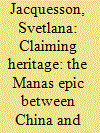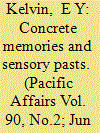| Srl | Item |
| 1 |
ID:
173334


|
|
|
|
|
| Summary/Abstract |
In this article I argue that the renewed promotion of the Manas epic in Kyrgyzstan after 2010 should not be reduced to an attempt to consolidate a national identity or strengthen the state by endorsing ethno-nationalism. Instead, since the 2009 inscription of the Manas epic on the UNESCO List of Intangible Heritage by China, Kyrgyzstan has undertaken a full-scale heritagization not only of the Manas epic but also of its other tangible or intangible cultural assets. This heritagization has been shaped by an anxiety that Kyrgyzstan’s most valuable cultural asset might be appropriated by China. By shifting the focus from Manas as a potential national role model to the epic as national heritage, I suggest that Kyrgyzstan’s latest outburst of ‘Manasification’ is better understood as an attempt to resist China’s ongoing attempts to harness the heritage discourse in rewriting the cultural and historical narrative of Eurasia.
|
|
|
|
|
|
|
|
|
|
|
|
|
|
|
|
| 2 |
ID:
154265


|
|
|
|
|
| Summary/Abstract |
This paper interrogates how Singapore’s everyday heritage has been framed through embodied and sensory experiences. While buildings and other landmarks have been conserved as heritage icons, this designation also includes particular routes known as heritage trails. Buildings and trails by themselves are not invested with symbolic meaning; it is the processes of heritage packaging that consign particular landmarks and sites with a heritage purpose. By employing the notion of “concrete memories,” I argue that heritage landmarks and trails form a site through which the nation’s history is selectively interpreted, negotiated, and experienced by different actants. Concrete memories comprise three key features: familiarity, sensory remembering, and ownership. The discussion of concrete memories is undergirded by broad methodological principles of actor-network theory. The intention is to call attention to embodied tourism in heritage tourism studies while at the same time addressing the production and consumption of heritage and power relations through heritage networks.
|
|
|
|
|
|
|
|
|
|
|
|
|
|
|
|
| 3 |
ID:
177582


|
|
|
|
|
| Summary/Abstract |
In China, ‘heritage’ as a terminological construction was shaped within specific discursive and organizational frames over the course of decades. As an outcome, UNESCO’s heritage discourse, universal by intention, was definitively redefined in China to adjust it to an ideology that would legitimize Chinese authorities’ cultural control over ethnic minorities. The heritagization of the genealogy writing tradition of the Chinese Sibe ethnic group as an integral part of this process, promotes the nation-building aspirations of powerholders. Taking the case study of an unpublished book as its starting point, this article examines the role performed by Sibe intellectuals in influencing how ‘common Sibe people’ think about their genealogy writing ‘heritage.’ It explores this process in its historicity with a focus on the textual strategies adopted by Sibe intellectuals who had to adjust to particular political and socio-cultural contexts.
|
|
|
|
|
|
|
|
|
|
|
|
|
|
|
|